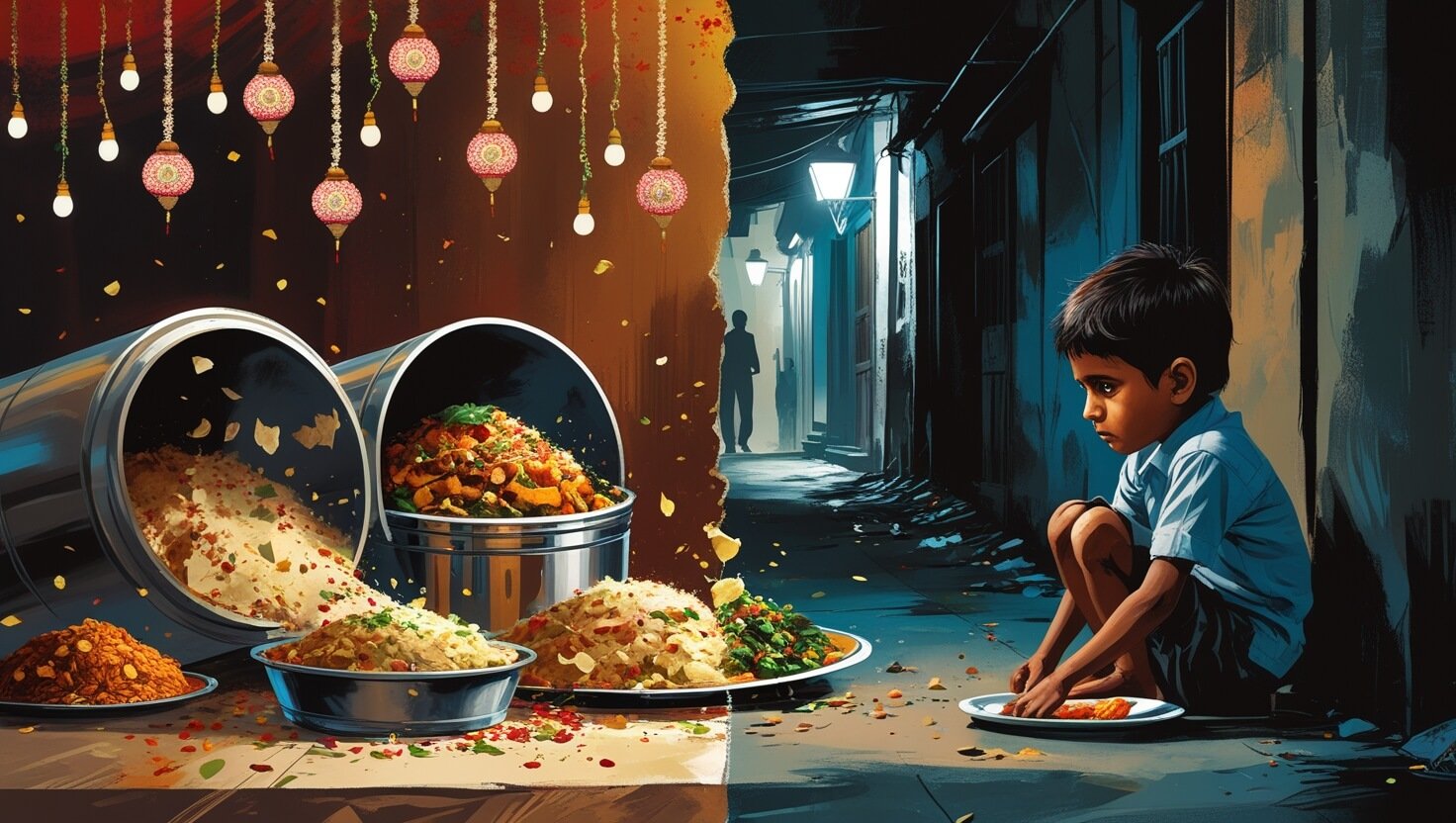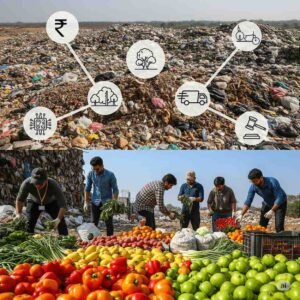Table of contents
- The Paradox of Plenty
- Food Loss vs. Food Waste — Know the Difference
- The Indian Kitchen Conundrum
- The Silent Leak: Food Lost Before It Ever Reaches Us
- The Missing Middle: Retail and Restaurants
- The Fallout: Hunger, Methane & Wasted Resources
- What’s Being Done — And What’s Still Missing
- The Way Forward: Conscious Living, Collective Action
- Final Thoughts: A Nation of Abundance Should Not Go Hungry
India’s Hidden Hunger: How Much Food Is Wasted Annually — And Why It Matters
On a bustling street in Delhi, 8-year-old Aarav quietly watches a wedding banquet wind down. Mountains of untouched food are scraped into black garbage bags. Across town, his mother struggles to feed him two meals a day. This is not fiction—this is India’s silent crisis.
Let’s unpack India’s hidden hunger and the staggering reality of how much food we waste.
In the land of festivals, feasts, and vibrant culinary traditions, a heartbreaking truth simmers quietly beneath the surface — millions of Indians go to bed hungry each night, while perfectly good food is discarded in vast, unimaginable quantities.
This isn’t just an irony. It’s a national emergency.
The Paradox of Plenty
India ranks among the world’s largest food producers, yet it also harbours one of the highest levels of child malnutrition globally. How can this be?
The answer lies in what we throw away.
Every year, India wastes food worth ₹50,000 to ₹92,000 crore — a financial loss nearing 1% of the country’s GDP. That’s not just rupees down the drain — it’s nourishment denied, potential squandered, and resources wasted in a country still grappling with widespread hunger.
India’s Food Waste Snapshot:
- ₹92,000 crore worth of food wasted every year
- 74 million tonnes lost annually
- 55 kg of food wasted per person per year
- Food waste = ~1% of India’s GDP
- 2nd highest household food waste in the world
To put it plainly: India loses about 74 million tonnes of food annually — enough to feed every hungry stomach several times over.
That’s equivalent to over 18,000 Olympic-sized swimming pools filled with wasted food.
Or enough to feed the entire population of Brazil for a year.
Food Loss vs. Food Waste — Know the Difference
Before we dive deeper, let’s clarify two often-confused terms:
- Food Loss: Happens before food even gets to us — during farming, harvesting, storage, and transport.
- Food Waste: Occurs after the food reaches consumers — at homes, markets, restaurants, and hotels.
Both are devastating. Together, they’re catastrophic.
The Indian Kitchen Conundrum
Think about it—have you ever made too much dal or rice, only to throw it out later?
Now imagine this happening in millions of Indian homes every day. Let’s dive into the scale of household food wastage.
Believe it or not, households are among the biggest contributors to food waste in India.
According to the UN’s Food Waste Index Report, Indian homes waste an estimated 68.7 to 78.2 million tonnes of food each year — about 55 kg per person annually.
That’s like every Indian tossing out a sack of perfectly edible rice — every single year.
India ranks second in global household food waste, just behind China. And though we waste less per person than many countries, the sheer size of our population amplifies the impact enormously.
The reasons? Leftovers forgotten in the fridge. Cooking more than needed. Cultural shifts away from the traditional “waste-not” wisdom our grandparents lived by.
The Silent Leak: Food Lost Before It Ever Reaches Us
❗️Did You Know?
India wastes more household food than any other country except China—yet our per person waste (55 kg/year) is among the lowest in South Asia. Rural India wastes far less than urban areas.
Now let’s move further up the chain.
India’s agricultural bounty often never makes it to our plates. From spoiled fruits during transportation to milk lost due to heat stress in dairy animals — the waste starts right after the harvest.
Here’s how much gets lost post-harvest, according to recent government studies:
- Fruits: 15.05%
- Vegetables: 11.61%
- Cereals: 5.92%
- Milk: 0.87%
- Meat: 2.34%
- Poultry & Fisheries: 4%–9%
In total, about one-third of all produce may never reach the consumer due to flawed storage, outdated logistics, or poor infrastructure. That’s 33.1% of annual production gone.
Add climate change to the mix — with its heatwaves, erratic rains, and pest surges — and the losses multiply.
The Missing Middle: Retail and Restaurants
Globally, 40% of food waste occurs in retail and hospitality. But in India, data from these sectors is surprisingly scarce.
Restaurants discard surplus food at closing time. Buffets overflow, weddings oversupply. Supermarkets throw out unsold but still-edible items. And yet — no consolidated national database tracks this layer of the problem.
Without numbers, policy remains toothless.
The Fallout: Hunger, Methane & Wasted Resources
This is not just a food problem. It’s a people problem. A planet problem.
- Hunger: India ranks 111th out of 125 countries in the Global Hunger Index. Around 194 million Indians don’t get enough food. The food we waste could nourish them all.
- Environment: Rotting food in landfills releases methane, a greenhouse gas 80x more harmful than CO₂. Food waste contributes 8–10% of all global GHG emissions.
- Wasted Resources: Producing 1 kg of rice needs 2,500 litres of water. Every morsel wasted means lost water, land, fuel, and the hard work of farmers.
What’s Being Done — And What’s Still Missing
India isn’t standing still. From the Solid Waste Management Rules (2016) to cold-chain infrastructure subsidies and food donation laws, steps are being taken.
But there are gaps:
- Lack of unified data
- Ineffective waste segregation
- Price crashes forcing farmers to abandon crops
- No single authority coordinating action
- Minimal awareness around consumer behaviour
NGOs, startups, and civic groups are trying to fill the void. From Wastelink converting waste to animal feed, to GreenPod Labs prolonging produce shelf-life, innovation is sprouting across the country. Yet, systemic change is still waiting at the gates.
The Way Forward: Conscious Living, Collective Action
It’s time to rediscover respect for food — something our ancestors practised instinctively.
- Buy only what you need
- Plan meals, store leftovers smartly
- Share surplus after events
- Support food redistribution efforts like Reshine Organisation
Change begins in the smallest of choices — in kitchens, canteens, and community halls.
Final Thoughts: A Nation of Abundance Should Not Go Hungry
Food in India has always been sacred. From offering the first morsel to God to feeding guests with love — we celebrate food. But somewhere along the way, excess replaced mindfulness, and convenience replaced compassion.
Now, we must return to our roots — with modern tools and united resolve.
Because in a nation that wastes nearly 80 million tonnes of food each year, no one should be hungry.
At Reshine Organisation, we believe that a better, more food-secure India is not only possible — it’s necessary. Join us as we build systems of sharing, saving, and serving food to those who need it most.
Want to know what we can do about this?
While this blog uncovered the alarming scale of food waste in India, the solution lies in food redistribution—a powerful approach to rescue surplus food and feed those in need.
Read our previous post on “What is Food Redistribution, and Why is It Important?” to understand how this simple yet impactful process can reduce waste, fight hunger, and create a more sustainable food system for India.




